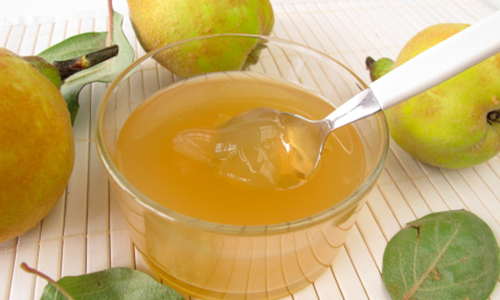
Ingredients for 4 servings:
- 4 quinces
- 1 walnut-size piece of ginger
- ¾ l dry white wine
- 5 sheets of white gelatine or approx. 18 g powdered gelatine
- 170-200 g brown sugar (depending upon desired sweetness)
Preparation:
- Rub quinces with a dry towel. Leaving the core, cut quinces into rough pieces and place into a pot. Peel, dice and add ginger. Pour in white wine. Let simmer for about 45 minutes until the quinces are completely soft.
- Soak gelatine in cold water.
- Place quinces together with the liquid into a conical sieve and carefully crush the fruit lightly with a spoon. Collect juice.
- Mix 450 ml of quince juice in a pot with the sugar. Dissolve sugar while stirring. Squeeze out gelatine and dissolve in quince juice.
- Fill clean twist-off jars with the hot jelly. Place the jars upside down on the work space for 10 minutes. Let cool completely.
Click here for more information on cooking and baking with gelatine.
Approx. nutrition facts per serving:
- Calories: 367
- Joules: 1539
- Protein: 2.5 g
- Fat: 0.5 g
- Carbohydrates: 53.4 g
The quince – a forgotten fruit
As temperatures begin to drop outside, this is the first sign that autumn is on its way. The perfect time of year to rediscover a well-known pome – the quince. While apples and pears are more than familiar, the quince has been suffering from neglect. And this undeservedly. With just a little more effort, the fruit can be as versatile in its uses as its relatives.
However, before you can do anything with this pome, you first need to thoroughly rub its fuzz off. This is quickly accomplished with a cloth or brush. The fruit should never be eaten raw because it will taste hard, bitter and tart. It is only after boiling that its true potential is revealed. Unfortunately, it will also lose its colourful yellow colour and turn a reddish brown. However, even though the reddish brown colouring of the quince looks unsightly, the fruit contains large quantities of vitamin C, potassium, sodium, zinc, iron, pectin and many other important nutrients.
There are endless possibilities for preparing the quince that emphasise its characteristic flavour. It can be made into jam, compote or a brandy that highlights its tart flavour. Baked, it can also be served as a side dish for meat or as a dessert.
The most well-known sweet that is made with quince is quince bread. For this, sugar is mixed into a thickened quince purée and then baked in the oven. Later, the sweet is cut into large diamonds and served rolled in sugar. In German-speaking regions, quince bread is not often found commercially. It is more commonly available in Spanish- or Portuguese-speaking countries, where it is sold under the name “Dulce de membrillo”.
Pomaceous fruit, or pomes, belong to the rose family and are harvested from September to November. It is best not to wait with harvesting until they are completely ripe, as the amount of pectin they contain diminishes increasingly. They originally came from the Eastern Caucasus and Trans-Caucasus regions. Today, however, they are primarily cultivated in Asia and Europe. The rounded, apple-shaped Cydonia oblonga maliformis quinces or the longer, pear-shaped Cydonia oblonga pyriformis quinces are the most common types. Both offer a wonderful flavour. While the apple-shaped quinces have dry-hard flesh, the pear-shaped quinces taste milder and softer.
However, both types can easily be used to prepare the most well-known quince recipe: quince jelly. It is delicious both as a fruit spread at breakfast or as an ingredient for other recipes. It is best to cook the pome with its peel, because, as is generally known, the important vitamins are to be found under the peel.